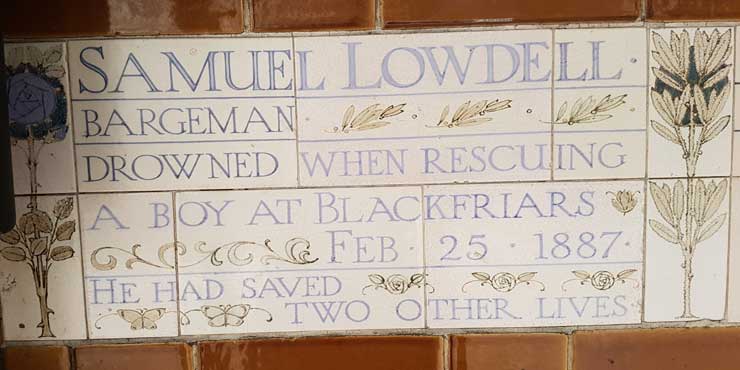
Samuel Lowdell (1864 - 1887) worked as a bargeman on the barge William and Mary which, on the evening of February 25th 1887, was moored at Bankside, on the south side of the Thames, across from St Paul's Cathedral.
Suddenly, a cry went up that someone had fallen into the water and, rushing to see what had happened, Samuel discovered that a boy named Buck, had toppled into the Thames and was clearly in difficulty.
Without hesitation Samuel, who appears had a history of saving similar souls in distress in the river, Samuel dived in to rescue the boy.
Unfortunately, he found himself trapped beneath a lighter that was moored alongside the barge and, despite the efforts of his crewmates, he sank beneath the murky waters of the Thames.
The boy, as it happens, was rescued by another boat, but there was no sign of Samuel Lowdell. he had, it was presumed, been drowned.
His memorial in Postman's Park reads, "Samuel Lowdell, Bargeman, Drowned When Rescuing A Boy At Blackfriars. Feb 25 1887. He Had Saved Two Other Lives."
It was almost a month before, on Wednesday 23rd March 1887, the body of Samuel Lowdell was finally found in the Thames and brought ashore.
On Sunday 27th March 1887 Lloyd's Weekly Newspaper published the following report on the finding of the body and of the inquest into his death:-
"Respecting the death of Samuel Lowdell, bargeman, aged 24, lately living at 6, Hill-place, Bow-common, Mr Langham, coroner, opened an inquiry yesterday morning at the Old King's Head public-house, Tooley-street, London-bridge.
Evidence of identification having been given, James Law, Bull-court, Tooley-street, waterman, said that on Wednesday evening he was on his boat at Battle-bridge stairs, when his attention was directed to an object floating in the water.
He immediately rowed to it, and found that it was the body of a man.
He towed the corpse ashore, and handed it over to a policeman, who removed it to the local dead-house.
The deceased's trowsers were down below his knees. He noticed he was tattooed about the arms.
Dr. Fitzrayne deposed that on examining the body he found the cartilage of the nose was broken, but this, in his opinion, had occurred after death.
He should say that all the appearances were consistent with death by drowning.
The coroner, addressing the Jury, said that that was the only evidence they had; and he did not think it was right that they should return a verdict without the evidence of persons who were witnesses of Lowdell's death.
This was not forthcoming that morning, and he should, therefore, adjourn the inquest until next Tuesday.
The jury acquiesced, and the proceedings then terminated.
It was incidentally mentioned that the deceased, who was employed on the barge William and Mary, jumped overboard to rescue a boy who had fallen into the river, but, although he (Lowdell) was a good swimmer, he was never seen again after he made the plunge.
It was also stated that the deceased had been the means of saving several lives from drowning."
Samuel Lowdell was buried in a common grave at Manor Park Cemetery, on 3rd April 1887.
A few weeks later, his courageous act of heroic self sacrificed was recognised by an award from the Royal Humane Society.
The Aberdeen Evening Express mentioned the award in an article that was published on 25th April 1887:-
"A testimonial on parchment, wit an award of money, was also awarded to the widow of Samuel Lowdell, who saved a boy named Buck at Blackfriars on February 25, but lost his life through being encumbered by his clothes.
This was the third life saved by Lowdell."